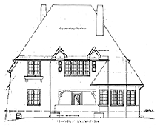
|
Pittsburgh
Architecture:
A Guide to
Research
|
Compiled by Martin Aurand
Carnegie Mellon University Architecture Archives
© Carnegie Mellon University Libraries
NOTE: This Guide is not being updated.
It includes
useful information but may be outdated in many aspects.
The built environment of the Pittsburgh region is the prototypical urban American industrial landscape, overlaid with an architecture of strength, variety, and invention. This environment has been decried by some and championed by others; but it has been largely ignored by students of architecture, and is only beginning to receive appreciation and serious study. Much work remains to be done.
This guide is intended to promote and facilitate architectural research in Pittsburgh and its region by introducing the researcher to methods and resources key to the research process. No guide can supply a universally applicable description of the process of architectural research. Every researcher has a different starting point and a different goal. However, a guide can offer direction, and it can provide information about the sometimes arcane tools of research, which may be of use to researchers of all stripes -- from scholars writing books or dissertations, to students working on class projects, to property owners researching the histories of their homes.
Architectural research is a sometimes complex but rewarding process, akin to assembling a puzzle, or doing detective work. Use this guide to identify resources that may have information about your topic. Contact each repository before you visit to learn about their hours and policies, and to identify the type of information that you will have to supply (e.g. address, date, etc.) in order to access their records. Do visit -- only you can spot and pursue every lead. And ask questions -- persistence will often pay off.
- Many records cited here for Pittsburgh and Allegheny County have their counterparts in other cities and counties.
- Many potentially useful repositories and resources are not listed here including
local governments, local libraries, utility companies, census records, biographical
sources, and geneological records.
- Look for articles in local newspapers and other publications from key dates associated with an
important building, for example its dedication or demolition.
- Often overlooked sources for information about individual buildings include the building itself, and the people who are currently associated with it.
Examine the building closely and interview the people.
- There is no one place to look for architectural drawings. Most do not survive the passage of time. If they do, it may be in one of three ways: they travel through time with the building itself, are submitted to municipalities along with building permit applications, or are saved by architects and their families. Even so, most municipalities and families do not save architectural records for very long. Only a very few drawings end up in permanent repository collections.
- Many prominent Pittsburgh buildings were designed by out-of-town architects, whose records may be in repositories in other cities.
- Augment your architectural research by researching individual people, businesses etc. You will learn about those who were involved with the buildings, and may find information about the buildings themselves.
- Pittsburgh's North Side was the independent City of Allegheny prior to its annexation in 1907. Other portions of the city were also independent municipalities at various times.
- Ward numbers, street addresses and even street names sometimes change over time.
